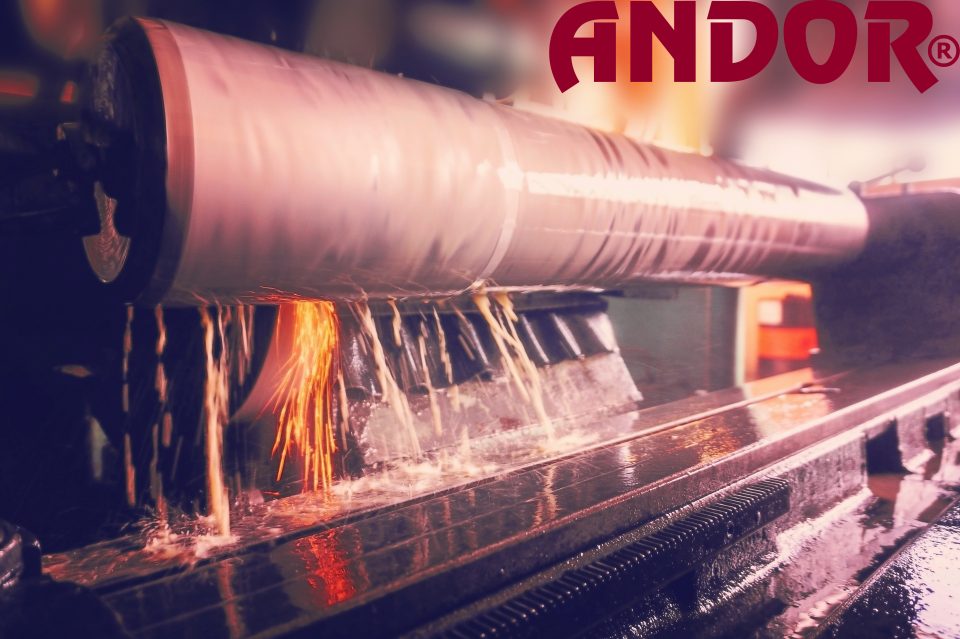The grinding of rolls for the paper mill industry is known to be one of the most difficult grinding operations. These rolls are normally very long relative to the outside diameter, hard in composition and have very tight tolerances and surface finish requirements to be met. In most cases, the grinding of paper mill rolls is a very time-consuming operation when it comes to both the roughing and finishing cycle of the process. Excellent operator skill and special attention to the grinding machine and its surroundings are also crucial factors when it comes to delivering a good and consistent result. Some of the common challenges faced in the grinding process might include, roll deflection and sag, vibration, wheel glazing, chatter marks, traverse marks and stainless-steel loading. The finishing process is commonly the most difficult and time-consuming as some rolls might take much longer than others to grind.

Choosing the correct grinding wheel for the roughing and finishing cycles of the grinding process is of utmost importance. Using a too hard or too soft wheel or even a wheel with the incorrect mineral and bond combination could lead to the loss of a lot of time during the grinding process. Grinding Techniques – a Tyrolit Company – is able to provide the Paper and Pulp Industry with local research and development capability as well as both locally manufactured Andor wheels, and imported Tyrolit wheels. Both the Andor and Tyrolit grinding wheels are specifically formulated and manufactured with the characteristics for successful roughing and finishing cycles in the grinding process.
Grinding wheels consist of abrasive grains held together by a resin bond. The abrasive normally used is black or green silicon carbide, which is a hard and sharp mineral and suited for most rolls used in the paper mill industry. In the grinding process, the grains’ sharp edges cut away the material and become dull (loses its sharpness) under the heat and pressure of the grinding process. The bond releases the dull grain from the wheel at the perfect time, exposing a new sharp edge of the grain, ensuring that these sharp edges are exposed for the full duration of the grinding wheel’s life cycle. Using the correct grinding wheel will ensure that more material is removed per pass with the minimal tendency of glazing and the least amount of dressing required.
Using two different wheels for the roughing and the finishing cycles when grinding paper mill rolls, have proven the most successful in the shortest time. For example, a grinding wheel used in the roughing cycle will generally be much too hard to be able to adhere to the required finish in the finishing process. The objective of the roughing wheel is to remove stock (material off the roll). Grinding Techniques takes the following aspects into consideration when specifying a rough grinding wheel suited for the Papermill Industry. The wheel needs to remove high volumes of material per pass whilst not having a tendency to burn the roll. The ideal wheel should also possess a free cutting action with minimum heat generated with the least dressing cycles required. A very consistent and uniform surface finish is also a top priority.
The finishing cycle of the grinding process has different characteristics compared to the roughing cycle. Considering the lower pressures and different speed and feed rates of the finishing cycle, the wheel matrix has to be adjusted accordingly. Lower grinding pressures could cause a wheel’s grains to dull and burn to the workpiece and chatter is often the result. The finishing cycle on roll grinding would require a finer grit wheel with a softer bonding system to release the dulled grains at lower pressures.
Contact Grinding Techniques, the largest South African producer of resin and vitrified abrasive products for a tailored solution to all your grinding processes of various paper mill rolls.
For more information contact us: +27 11 271 6400 | info@grindtech.com | www.grindtech.com



